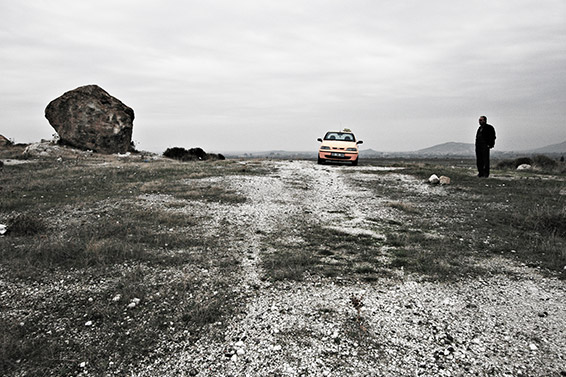
Alum
2009-2013
Knowledge of alum, a metal salt, goes back to the alchemists. For centuries alum was the unrivaled mordant for permanent fixing dyes and printing in color, the sources and recipes for its use very privileged, highly secret, information. The finest grades of the mineral salt were in high demand wherever the finest luxury woven goods were produced. Alum became so sought after that the world’s supply became hostage to strategies for controlling the market by the Pope, the Medici, Henry VIII and the Ottoman Emperor. With the advent of carbon-based ‘synthetic’ dyes, mordants were no longer needed, and alum’s power, like the colors once dyed without it, faded away.
In winter of 2009, Fels traveled to the Middle East and Europe, conducting research in Greece, Syria, and Turkey (where historically the best alum was produced) and England (where it was both produced and consumed). He explored the remains  of key alum mines and alum works where the mordant was produced after mining. In 2010, as a Jack Straw Writing Fellow, he began writing about his search for alum landscapes. In 2012, as fellow of the Northwest Institute, he traveled to Civita Bagnoregio, Italy from where he researched Tolfa, the site of the alum mines of the Pope and the Medici. The alum project juxtaposes the geographic and geopolitical realities of 500 years ago (when alum production was most important), with the virtual invisibility and symbolic reach of those sites today.
of key alum mines and alum works where the mordant was produced after mining. In 2010, as a Jack Straw Writing Fellow, he began writing about his search for alum landscapes. In 2012, as fellow of the Northwest Institute, he traveled to Civita Bagnoregio, Italy from where he researched Tolfa, the site of the alum mines of the Pope and the Medici. The alum project juxtaposes the geographic and geopolitical realities of 500 years ago (when alum production was most important), with the virtual invisibility and symbolic reach of those sites today.
In 2013, Fels traveled to Java, Indonesia, where with Javanese botanical researchers he searched for the wild Symplocos tree, introduced from India millennia ago to supplant the need for alum salt as a mordant. The tree, an aluminum accumulator, contains large amounts of the metal in its leaves and bark, and was once used widely on the island in batik dyeing. A resurgence of interest has made finding the trees, which grow at high altitudes, of interest again.
Fels’ exploration of alum’s evocative history became the basis for a larger work on the role of color and its global sourcing, which has now also taken him to India. In several places where he has visited, alum production once brought wealth and prestige. The mines have long been abandoned, as has the history itself. Fels has become fascinated by the way landscape holds and lets go of memory.



